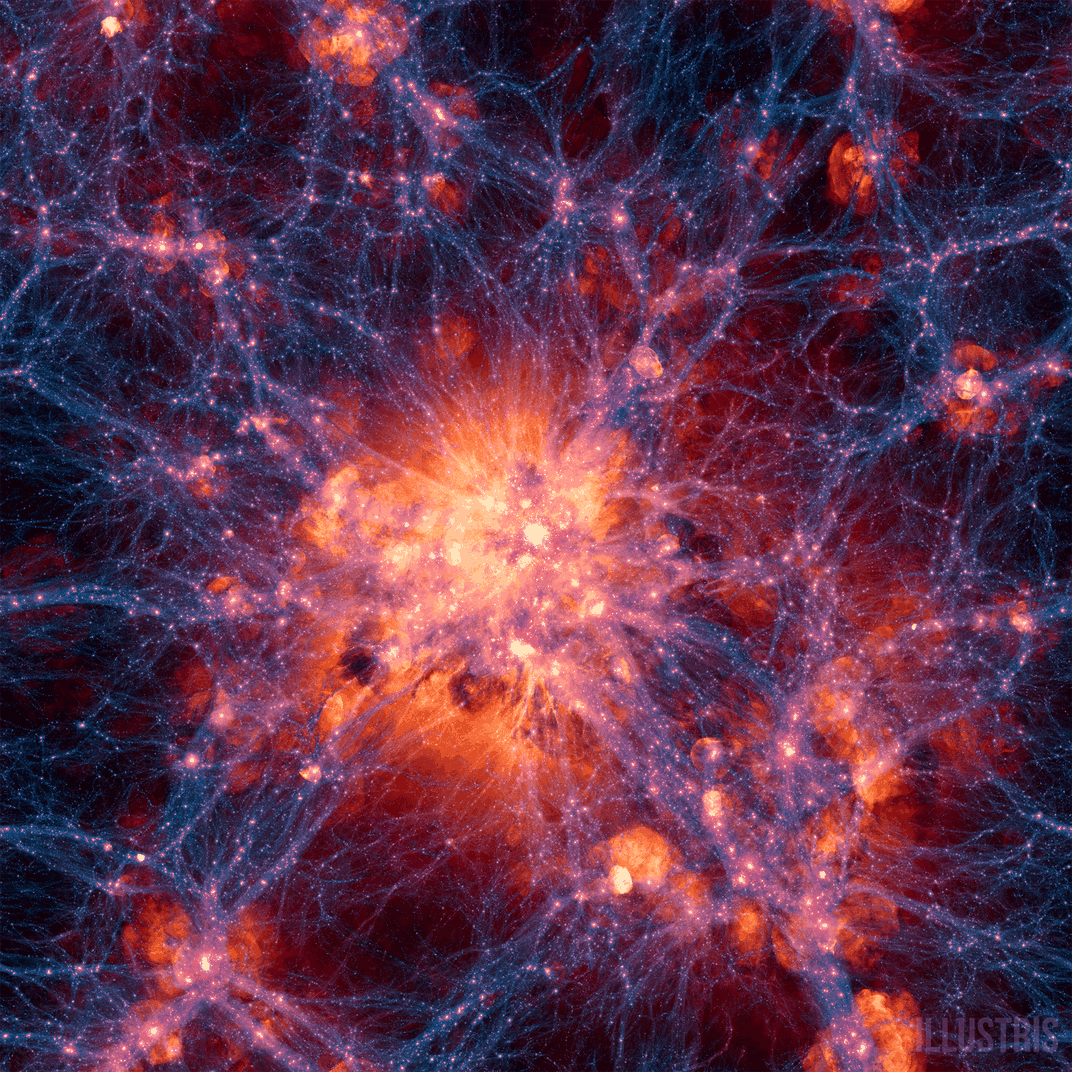Watch the Universe Evolve Over 13 Billion Years
A new computer simulation, called Illustris, can take you on an epic journey through space and time
We’ve seen time-lapse video of trees growing or mountains forming, even of the surface of the Earth sped up to show how continents moved to their present-day configurations and will move in the future.
Now, we can see time-lapse imagery of the universe evolving—13 billion years of cosmic evolution, all within a cube 350 million light-years on a side—shrunk to the screen of our computers. The video above weaves us through time and space as gas heats, stars explode, galaxies form, black holes devour and the universe expands. We see the vast expanses of space mapped as dark matter, as gas temperature, as heavy metals, as visible light—data that overlaps and overlays through 12 billion 3-D pixels.
"Until now, no single simulation was able to reproduce the universe on both large and small scales simultaneously," says Mark Vogelsberger of the MIT/Harvard-Smithsonian Center for Astrophysics (CfA). Vogelsberger, along with researchers in Germany, the U.K., and other institutions in the U.S., unveiled their simulation yesterday in Nature.
This virtual but realistic universe was built with a computer program called Illustris, which employed complex code to build the universe from its infancy, some 12 million years after the Big Bang.

Creating a program that spans billions of years of time fittingly required a long time investment on the human scale—researchers spent five years developing Illustris. Within that, actual calculations took three months of “run time” on supercomputers and involved a whopping 8,000 central processing units (CPUs, each being the "brain" of a computer) working simultaneously. For comparison, the average desktop computer working alone would have completed this task in 2,000 years.
When the computation finished at present day, Illustris had built more than 41,000 galaxies, along with galaxy clusters and voids, that the researchers say capture the essence of the actual universe very well. Zooming in reveals a resolution so fine that it's capable of showing the chemistries of gases swirling in individual galaxies.
Just how does the simulation work? One tiny aspect is based on a fundamental principle of light, the fastest substance in the universe. Light travels at a known speed—299,792,458 meters per second—so when we use telescopes to look at a galaxy one billion light-years away, we’re seeing the past—light that was emitted one billion years ago. Thus the farther away astronomers look, the father back in time they can see.
But observations from telescopes only create discrete pieces of the universe’s evolution and don't allow anyone to view how, say, a specific galaxy morphs through time. So the researchers who built Illustris had to fill in huge gaps in space and time by probing the fundamentals of how normal matter, dark matter and dark energy—the main “stuff” of the universe—interact in space. As you might expect, complex physical and chemical processes influence how cosmic structures form.
Current thought suggests that the evolution of features in space “is a self-regulating process, in the sense that the structures that form, in particular stars and black holes, affect their surroundings and the subsequent evolution of the next generation of structures,” the authors write on Illustris’ site. “In Illustris, a comprehensive (even if not complete) set of physical processes such as star-formation-driven galactic winds, and black hole thermal energy injection, are modeled throughout cosmic history.” Such simulations are key to creating a realistic set of modeled galaxies.
Other videos produced by the authors show specific slices of the simulation—13 billion years of gas temperatures in space, or the complete evolution of a particular galaxy. "Illustris is like a time machine,” says co-author Shy Genel of the CfA. “We can go forward and backward in time. We can pause the simulation and zoom into a single galaxy or galaxy cluster to see what's really going on."
And we can also gaze in wonder, as we fly through filaments reminiscent of neural networks, at the sheer size of space and time and humanity’s power to simulate it.
/https://tf-cmsv2-smithsonianmag-media.s3.amazonaws.com/accounts/headshot/mohi-kumar-240.jpg)
/https://tf-cmsv2-smithsonianmag-media.s3.amazonaws.com/accounts/headshot/mohi-kumar-240.jpg)